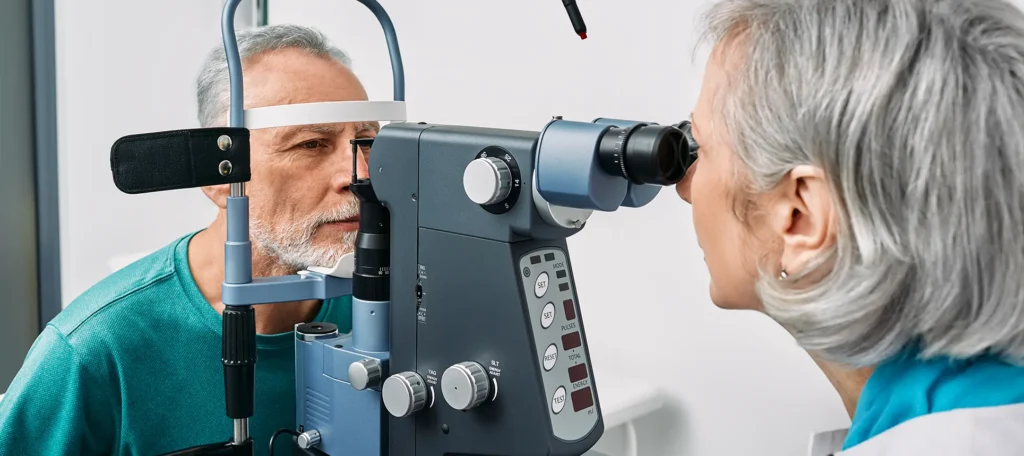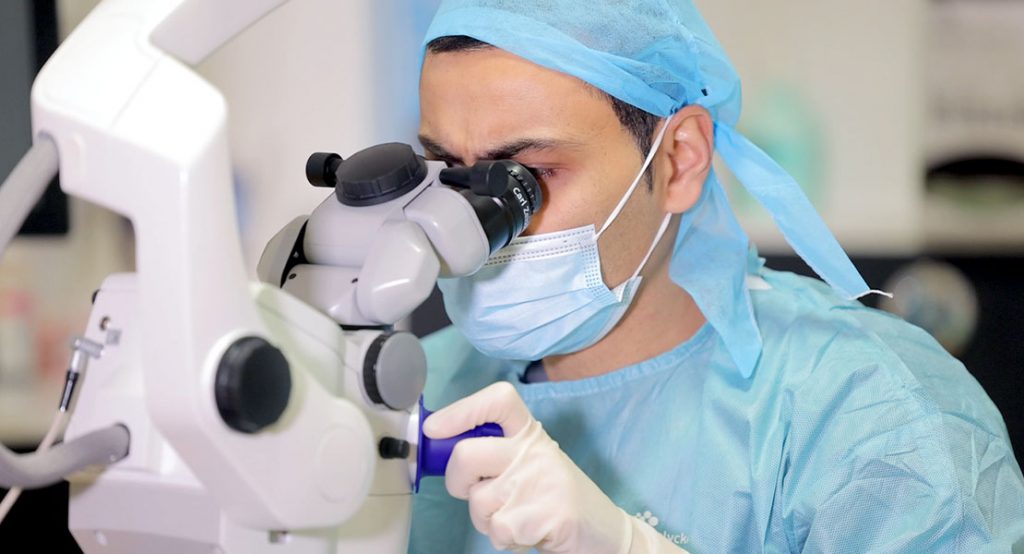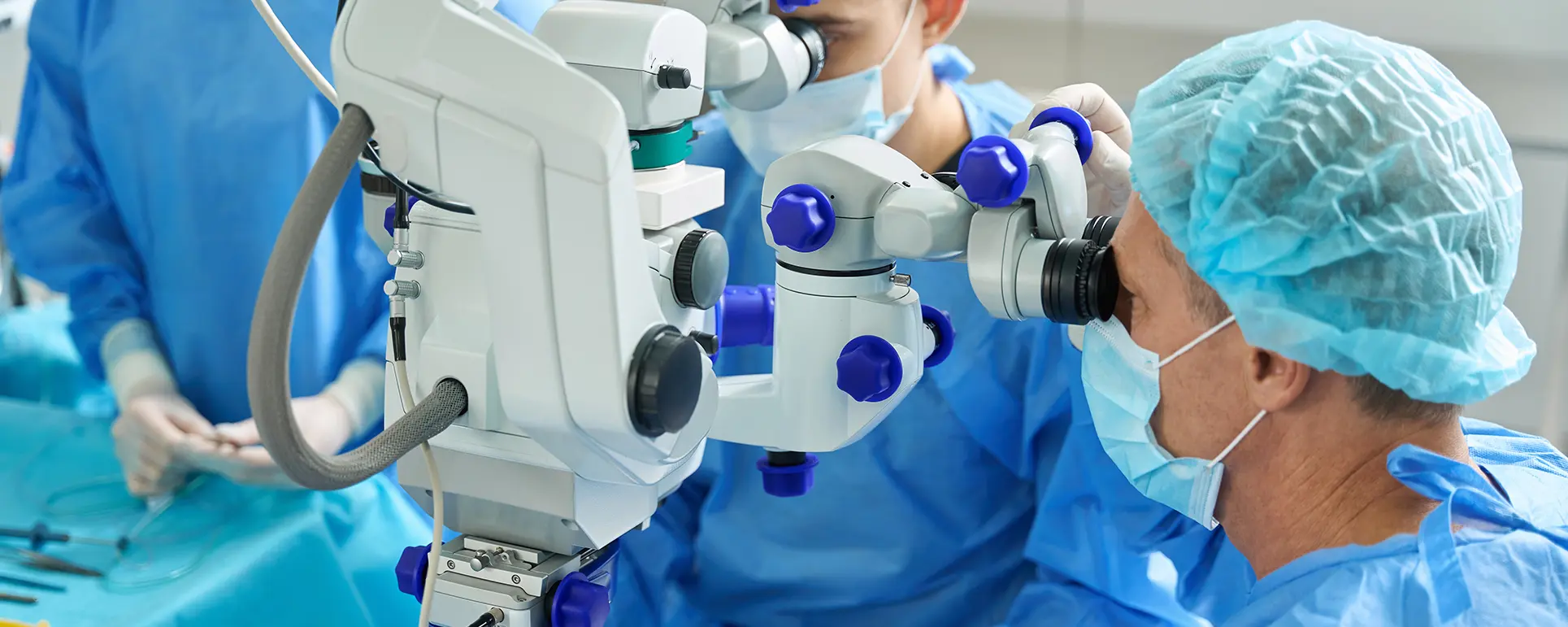If you’ve been told you need cataract surgery in both eyes, you might assume it means two separate operations weeks apart. But what if you could have both eyes done on the same day? That’s exactly what Immediate Sequential Bilateral Cataract Surgery (ISBCS) offers—and it’s changing the conversation in eye care. In this article, we’ll take a deep dive into the facts, weigh up the pros and cons, and explore whether ISBCS could become the standard approach in the years to come.
What is ISBCS?
ISBCS simply means performing cataract surgery on both eyes during the same surgical session. It’s different from the traditional method—Delayed Sequential Bilateral Cataract Surgery (DSBCS)—where each eye is operated on weeks apart, giving time for recovery and vision stabilisation in the first eye before moving onto the second.
With ISBCS, each eye is treated as a separate case during the same visit: separate surgical instruments, separate drapes, and often different operating staff to minimise any risk of cross-contamination or bilateral complications. It’s efficient, potentially cost-saving, and for many patients, hugely convenient. But it’s not without its controversy.
The Shift Towards Efficiency in Eye Surgery
Let’s face it—NHS resources are stretched, and private clinics are under pressure to improve patient flow. With cataract surgery being the most commonly performed procedure in the UK, finding safe ways to increase efficiency is critical. ISBCS fits perfectly into that picture.
From a system-level perspective, doing both eyes in one sitting can free up surgical time, reduce waiting lists, and cut down the number of pre- and post-op appointments. When done correctly, it has the potential to dramatically reduce the burden on both patients and providers. For that reason alone, it’s increasingly being discussed as a serious alternative to traditional approaches.

Is It Safe to Operate on Both Eyes at Once?
The biggest concern with ISBCS has always been safety. Understandably, many people feel apprehensive about having both eyes operated on in one go. What if something goes wrong? What if an infection occurs and affects both eyes?
This concern isn’t just patient-driven—ophthalmologists have historically been cautious too. The main fear is bilateral endophthalmitis, a rare but devastating infection inside the eye. To mitigate this risk, strict protocols are followed during ISBCS. These include using completely separate surgical trays, separate gloves and gowns, and even switching to a different set of intraocular lenses and eye drops for the second eye.
When protocols are followed to the letter, studies show that the risk of bilateral endophthalmitis is exceedingly low—close to zero. In fact, some countries like Finland and Spain have adopted ISBCS as a routine option with excellent outcomes.
Evidence From Clinical Trials
Research into ISBCS is growing rapidly, and the evidence base is becoming increasingly robust. Several large studies and meta-analyses have found no significant difference in complication rates between ISBCS and DSBCS when performed under strict aseptic conditions.
Visual outcomes are also comparable, and in many cases, patients undergoing ISBCS report faster overall recovery and satisfaction due to the convenience of not having to wait weeks between procedures. One randomised trial involving over 800 patients even reported slightly higher patient satisfaction with ISBCS, primarily due to reduced time off work and less travel for follow-up appointments.
What About Refractive Surprises?
A legitimate concern raised by some ophthalmologists is the inability to “adjust” the lens power for the second eye based on the refractive outcome of the first eye. With DSBCS, surgeons often use the results of the first eye to fine-tune the lens choice for the second, which can improve overall accuracy.
ISBCS removes that opportunity, but with the advent of modern biometry and intraocular lens (IOL) calculation formulas, this issue is becoming less relevant. Today’s lens calculations are so precise that the incidence of major refractive surprises has dropped significantly, making ISBCS a far more viable option than it once was.
Who Are the Best Candidates for ISBCS?
Not everyone is suitable for ISBCS. The ideal candidate is someone with similar cataract severity in both eyes, no history of eye disease, and no unusual anatomical features that would complicate the surgery. People with stable health, good immune function, and reliable transport support also make excellent candidates.
If you’ve got glaucoma, diabetic retinopathy, macular degeneration, or previous retinal detachment surgery, you’re less likely to be considered. In such cases, your surgeon might prefer to operate on one eye first, assess the results, and then plan the second accordingly.
Patient Satisfaction and Recovery Time
One of the biggest advantages of ISBCS from the patient’s perspective is convenience. Imagine only having to fast once, take time off work once, travel to the hospital once, and recover once. It’s no wonder that patient satisfaction scores are often higher in those who choose ISBCS over the traditional route.
Recovery also tends to feel quicker overall. With both eyes healing at the same time, patients avoid the temporary imbalance in vision that can happen when one eye sees clearly and the other still has a cataract. For many, this means less confusion, less eye strain, and a smoother adjustment to post-operative vision.

Financial Benefits: Patient and Provider Perspectives
From a financial standpoint, ISBCS offers potential savings for both healthcare systems and patients. NHS studies suggest that performing ISBCS could cut cataract surgery costs by up to 30% per patient due to fewer appointments, reduced use of theatre time, and consolidated recovery periods.
For private patients, fewer appointments and days off work can mean significant savings in transport, lost wages, and childcare. However, not all insurers currently reimburse for both eyes if done on the same day, which remains a barrier to widespread adoption in the private sector.
What Do UK Guidelines Say?
As of now, the Royal College of Ophthalmologists in the UK doesn’t formally recommend ISBCS as standard practice, but it doesn’t prohibit it either. It advises that the decision should be made on a case-by-case basis, with full informed consent and strict adherence to surgical protocol.
The General Medical Council (GMC) also stresses the importance of individualised risk-benefit assessments. In other words, your ophthalmologist must be confident that ISBCS is in your best interest—not simply more convenient for scheduling.
International Adoption of ISBCS
In countries like Finland, ISBCS is already standard practice in many clinics. High patient volumes, long distances to surgery centres, and robust national guidelines have made it a sensible solution there. In Canada, some centres have adopted ISBCS for specific patient groups with excellent outcomes.
In the UK, uptake is slower, partly due to medico-legal concerns, lack of universal protocols, and varied NHS commissioning policies. But as the evidence continues to mount and surgical techniques evolve, it’s likely that more eye centres will begin to offer ISBCS as an option.
Legal and Ethical Considerations
Performing two surgeries in one day naturally comes with legal and ethical responsibilities. Full consent is crucial—not just for the surgery itself, but specifically for the bilateral approach. Patients must understand that they forgo the opportunity to adjust the second lens based on the first eye’s results and accept the (albeit small) risk of simultaneous bilateral complications.
For surgeons, there’s a strong duty of care to follow sterilisation protocols to the letter. Any breach of these procedures could open up liability issues, especially in the rare event of a complication.
Psychological Impacts on Patients
Beyond logistics and safety, there’s a psychological angle to consider too. Some patients are more anxious about surgery than others. For them, the idea of having both eyes done in one go can be overwhelming. But for others, especially those with carer responsibilities or jobs that don’t allow for multiple recoveries, ISBCS can actually reduce anxiety and disruption.
Psychological satisfaction tends to be higher in patients who are well-informed and actively involved in choosing ISBCS. So, communication really matters here—patients need to feel confident and prepared.
Technology Is Making ISBCS Safer
Today’s surgical tools and biometry systems are making ISBCS safer than ever. From femtosecond laser-assisted cataract surgery to real-time intraoperative aberrometry, there’s a growing arsenal of technology that can minimise error and improve outcomes.
Advanced lens designs, such as toric and multifocal IOLs, are now easier to customise preoperatively with biometric data. And with artificial intelligence entering the fold, predicting the best lens power for each eye may soon be more accurate than ever—making the ISBCS decision less of a gamble and more of a science.
Surgeon Perspectives: Divided but Evolving
Ask ten cataract surgeons what they think of ISBCS, and you’ll probably get ten different answers. Some embrace it fully, citing efficiency and convenience. Others remain cautious, especially when it comes to medico-legal risk or losing the chance to correct the second eye.
But views are shifting. Younger surgeons trained in modern aseptic techniques and digital biometry often feel more confident performing ISBCS. As more centres adopt comprehensive protocols and demonstrate successful outcomes, it’s likely that scepticism will give way to confidence.

Potential Downsides to Consider
While ISBCS has plenty of positives, it’s important to acknowledge the potential drawbacks:
• No chance to adjust second eye lens power
One of the most significant clinical considerations with ISBCS is the inability to fine-tune the intraocular lens (IOL) power for the second eye based on the refractive outcome of the first. In delayed sequential surgery, surgeons often take the results from the first eye—especially if the outcome wasn’t exactly as predicted—and use that data to make micro-adjustments to the second lens choice. This approach can enhance overall binocular vision, particularly in patients who are aiming for spectacle independence or have complex optical histories.
When both eyes are operated on during the same session, that opportunity disappears. The lens powers must be chosen in advance for both eyes, based purely on pre-operative biometry. While modern measurement tools and lens calculation formulas have dramatically improved accuracy, the chance of a minor refractive surprise remains. For patients with a strong preference for perfect distance or near vision without glasses, this could be a drawback. That’s why it’s so important to have a thorough discussion with your surgeon about realistic expectations and whether refractive precision or surgical convenience should take priority in your case.
• Longer time in theatre (though total time is less than two separate surgeries)
ISBCS naturally requires more time in theatre during the individual session, since both eyes are being operated on consecutively. This includes double the preparation, draping, and instrument sterilisation within the same surgical timeframe. For surgical teams, this means a slightly longer block per patient, which may impact scheduling—particularly in smaller clinics or busier lists where surgical time is at a premium.
However, when you compare this to the total operating time needed for two completely separate surgeries, ISBCS actually comes out more efficient overall. The theatre is only set up once, anaesthesia is only administered once, and recovery teams deal with just a single post-op cycle. This efficiency can benefit both the clinic and the patient, especially in high-volume centres. Still, the immediate time commitment on the day of surgery is worth discussing, particularly for patients with mobility issues, comorbidities, or a tendency to fatigue easily.
• Slightly higher patient anxiety on the day of surgery
It’s completely natural to feel nervous before eye surgery—your vision is precious, and the idea of undergoing a procedure on even one eye can cause stress. With ISBCS, that anxiety can be amplified by the knowledge that both eyes will be operated on in a single session. Some patients worry about the outcome, fear complications, or simply feel overwhelmed by the idea of a more intensive surgical experience.
That said, anxiety levels often drop significantly after clear communication and reassurance from the surgical team. Many patients actually report a sense of relief post-operatively, knowing that they won’t have to return for a second surgery and can move forward with full visual recovery. Still, if you’re someone who experiences medical anxiety or has had negative healthcare experiences in the past, it’s vital to bring that up during your consultation. Your surgeon may recommend a more gradual approach or enhanced support on the day to help ease nerves and build confidence in the process.
• Limited suitability for high-risk patients
ISBCS is not a one-size-fits-all solution. For patients with certain pre-existing eye conditions—such as diabetic retinopathy, glaucoma, uveitis, or a history of retinal detachment—it may not be the safest approach. These conditions can increase the risk of complications or require highly individualised lens power calculations that benefit from the staggered feedback loop offered by delayed surgery.
There are also systemic considerations. Patients who are immunocompromised, prone to infection, or have cardiovascular issues that make prolonged surgery risky may not be ideal candidates. In these cases, surgeons often opt to play it safe and address each eye independently. This cautious approach ensures that if any issues do arise, they can be managed without putting both eyes at risk. So while ISBCS has many benefits, it must be carefully reserved for those whose overall health profile supports a same-day bilateral procedure.
• Not always covered by insurance providers
One of the less discussed but still important drawbacks of ISBCS lies in the financial and administrative realm—specifically, insurance reimbursement. In some regions and under certain private insurance plans, reimbursement policies are not yet aligned with the practice of same-day bilateral surgery. This can lead to lower overall reimbursement for the provider or result in the second eye not being covered at all, even though it receives the same care and resources as the first.
For patients, this can translate to unexpected out-of-pocket expenses if the policy doesn’t recognise both procedures independently. While this is beginning to change as the procedure gains more recognition and support from professional bodies, it’s still a grey area in many systems. If you’re considering ISBCS privately, it’s essential to confirm exactly what your insurance will cover and what costs you might incur. Transparency on this front can help avoid surprises and support better decision-making when comparing ISBCS to the traditional delayed route.
For many, these are manageable trade-offs—but they’re worth considering carefully with your surgeon.
Is ISBCS the Future?
So, is Immediate Sequential Bilateral Cataract Surgery the future? The answer isn’t a straight yes or no—it’s a cautious “probably.” For the right patients, in the right hands, with the right protocols, ISBCS offers compelling benefits in terms of safety, cost-efficiency, and satisfaction. As the UK grapples with growing cataract waiting lists and the need for streamlined surgical pathways, ISBCS could be an important part of the solution.
But this future hinges on strong clinical governance, proper training, and better alignment between NHS policies and private sector offerings. It also depends on patient education—because ultimately, this is a decision that must be made together with your ophthalmologist, based on your individual case and comfort level. If you’re considering private cataract surgery and would like expert guidance on whether ISBCS or another approach is best for you, feel free to get in touch with us at the London Cataract Centre to book a consultation with one of our experienced surgeons.
References
- Arshinoff, S.A. & Bastianelli, P.A., 2011. Immediate sequential bilateral cataract surgery: Financial risks and medico-legal aspects. Canadian Journal of Ophthalmology, 46(6), pp.490–496.
- Lundström, M., Albrecht, S. & Roos, P., 2006. Immediate versus delayed sequential bilateral cataract surgery: An analysis of costs and patient value. Acta Ophthalmologica Scandinavica, 84(6), pp.683–689. Available at: https://onlinelibrary.wiley.com/doi/10.1111/j.1600-0420.2006.00746.x [Accessed 19 May 2025].
- Sharma, B., Fraenkel, G.E., Johnson, I.L. & Hodge, W.G., 2010. Immediate versus delayed sequential bilateral cataract surgery: A systematic review and meta-analysis. Journal of Cataract & Refractive Surgery, 36(6), pp.1001–1012. https://doi.org/10.1016/j.jcrs.2009.11.032 [Accessed 19 May 2025].
- Johansson, B. & Lundström, M., 2014. Visual outcome and safety of immediate sequential bilateral cataract surgery (ISBCS) compared with delayed surgery: A register study from Sweden. Journal of Cataract & Refractive Surgery, 40(6), pp.1026–1033.
- Royal College of Ophthalmologists, 2021. Clinical guidelines on cataract surgery. [online] London: Royal College of Ophthalmologists. Available at: https://www.rcophth.ac.uk/resources-listing/cataract-surgery-guidelines/ [Accessed 19 May 2025].

